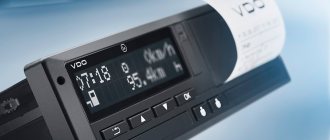Traffic regulations on tinting:
In clause 7.3. “The list of faults and conditions under which the operation of the vehicle is prohibited” (Appendix to the Traffic Rules) states that the operation of the vehicle is prohibited if:
Additional objects have been installed or coatings have been applied that restrict visibility from the driver's seat.
Note. Transparent colored films can be attached to the top of the windshield of cars and buses. It is allowed to use tinted glass (except for mirror glass), the light transmission of which complies with GOST 5727-88. It is allowed to use curtains on the windows of tourist buses, as well as blinds and curtains on the rear windows of passenger cars if there are external rear-view mirrors on both sides.
IMPORTANT! Analysis of the Technical Regulations of the Customs Union: what will change from January 1, 2015?
On January 1, 2015, the Technical Regulations of the Customs Union TR CU 018/2011 “On the safety of wheeled vehicles” comes into force.
What changes should vehicle owners prepare for?
Technical regulations - what is it?
Technical regulations are the highest technical regulatory legal act in the body of state legislation.
The entire regulatory framework of the state in the field of safety requirements for wheeled vehicles must be rebuilt to meet the requirements of the Technical Regulations.
The requirements of the Technical Regulations are mandatory and cannot be adjusted by national legislation, since:
Technical regulations are a document establishing mandatory requirements for vehicles for application and execution in the territory of the Customs Union;
The technical regulations have direct effect on the territory of the Customs Union;
The technical regulations contain requirements for vehicles that cannot be supplemented or tightened by national legislation.
A member country of the Customs Union can only determine the procedure and scope of verification of compliance with the requirements for vehicles in operation.
It must be emphasized that checking compliance with the requirements of the Technical Regulations is a complex action carried out:
- personnel of motor transport and other organizations during monitoring of the technical condition of vehicles;
- employees of car service companies during warranty and post-warranty maintenance of vehicles;
- by traffic police officers during control of vehicles participating in road traffic;
- by employees of diagnostic stations during the technical inspection of vehicles and their admission to participation in road traffic;
- by car owners during the operation of vehicles.
From January 1, we will have to switch to monitoring another condition, which is interpreted by the Technical Regulations as “vehicle safety”.
That is, not all parameters of the technical condition and design of the vehicle will be checked, but only those that ensure the inadmissibility or minimization of the risk of harm to the life or health of citizens, the property of individuals and legal entities, state or municipal property, and the environment.
This will allow you to waive a number of checks that have nothing to do with vehicle safety, which we will discuss below. Main changes 1. Defects in the appearance of vehicles are not considered by the Technical Regulations as a threat to their safety
The technical regulations do not contain any requirements regarding the appearance of the car (unlike the current traffic rules and technical regulations). As mentioned earlier, the state inspection is designed to primarily monitor the safety of the vehicle and reduce the risk of possible harm. In this regard, for example, a scratch, a small dent, a body element painted in a different color, a sticker, or airbrushing do not affect the safety of the car in any way. Therefore, from January 1, employees conducting state inspections will not be interested in damage (if it does not affect structural elements of the vehicle), stickers, or even the color of the car. 2. Braking system: slight tightening In contrast to the current TCH, the braking efficiency standards for vehicles of categories M and N will be brought under uniform indicators. The specific braking force for category N (vehicles for transporting goods) will be 0.45, for category M (vehicles for transporting passengers) - 0.5. 3. Steering: practically unchanged. The requirements for the total play in the steering remain almost the same. True, requirements have appeared for quadricycles, and all vehicles of category N (vehicles intended for transporting goods) fall under the same standard - 25 degrees. 4. In winter, it will be necessary to “change your shoes.” The document entering into force stipulates that from December to February, winter tires must be installed on the wheels of the car. At the same time, car owners must be prepared for the fact that this period can be extended at the national level, which is allowed by the Technical Regulations.
5. Environmental parameters If previously cars running on gasoline and gas fuel were checked for the permissible content of carbon monoxide and hydrocarbons only when running on gasoline, then from January 1, 2015, testing will be carried out on both types of fuel. However, testing for hydrocarbon content will not be carried out.
6. Rear windows of passenger cars: according to the Technical Regulations, tinting is not prohibited. I think that this is a very pressing issue for all car owners. Here it is necessary to note the following: The technical regulations clearly impose requirements for the light transmission of only the windshield and glass through which forward visibility is provided for the driver (that is, front windows) - their light transmission must be at least 70%. However, this requirement does not apply to rear windows (glasses that provide visibility for the driver from behind) of category M1 (passenger cars), provided that the vehicle is equipped with external rear-view mirrors.
7. With cars certified for the American market, the issue has not been fully resolved. The technical regulations fully comply with European requirements for external lighting devices of vehicles. This means that the light emitted by the direction indicators must be yellow, and headlights with gas discharge light sources (xenon) can only be used if the vehicle is equipped with automatic headlight leveling and headlight cleaning devices. However, cars certified for the American market do not meet European requirements. The light emitted by their direction indicators is red. As a rule, there are no headlight cleaning devices. In relation to registered “Americans”, the Technical Regulations introduced two concepts that allow them to feel calm from January 1, 2015. The first is that the color of the lights of external lighting devices is determined by the vehicle manufacturer. As for the corrector and headlight washers, the “Americans” have not been certified for compliance with UNECE Regulation No. 48, therefore, they may not have these devices. 8. Noise will be checked From January 1, diagnostic stations will begin technical monitoring of noise pollution. The maximum exhaust noise levels of vehicle engines should not exceed the standards established by the manufacturer by more than 5 dBA. In the absence of such data, the noise of passenger cars, trucks with a technically permissible total weight of up to 3.5 tons and motor vehicles will be limited to 96 dBA. The noise of “large” buses and trucks with a technically permissible total weight of more than 12 tons is 100 dBA. 9. Passenger taxi cars The technical regulations do not impose additional requirements for the external design of their vehicles, which means that these requirements will not be reflected in the new technical inspection document. www.ati.su
FROM THE EDITOR: Let us remind you that the Technical Regulations of the Customs Union “On the safety of wheeled vehicles” were approved by decision of the Customs Union Commission dated December 9, 2011 No. 877.
Decision of the Board of the Eurasian Economic Commission dated December 9, 2014 No. 232
GOST 5727-88 about tinting:
(this GOST has become invalid since 01/01/2015)
Clause 2.2.4. The light transmission of glass providing visibility to the driver must be no less than:
75% - for windshields;
70% - for glasses that are not windshields, included in the standard field of view P, which determines forward visibility
See picture
Technical regulations on the safety of wheeled vehicles on tinting:
Appendix No. 5 to the Technical Regulations:
"3.5.2. The light transmission of the windshield, front side windows and front door windows (if equipped) must be at least 70 percent.
3.5.3. In the upper part of the windshield of vehicles of categories M1, M2 and N1, it is allowed to mount a strip of transparent color film with a width of no more than 140 mm, and on vehicles of categories M3, N2 and N3 - with a width not exceeding the minimum distance between the upper edge of the windshield and the upper border zones for cleaning it with a windshield wiper. In this case, the light transmission requirements established in paragraph 3.5.2 must be met.”
Note: Category M - vehicles that have at least four wheels and are used for the transportation of passengers Passenger cars, including: Category M1 - vehicles used for the transportation of passengers and having, in addition to the driver's seat, no more than eight seats. Buses, trolleybuses, specialized passenger vehicles and their chassis, including: Category M2 – vehicles used for the transport of passengers, having, in addition to the driver’s seat, more than eight seats, the technically permissible maximum weight of which does not exceed 5 tons. Category M3 – vehicles used for the transport of passengers, having, in addition to the driver’s seat, more than eight seats, the technically permissible maximum weight of which exceeds 5 tons.
Category N - vehicles used for the transportation of goods - trucks and their chassis, including: Category N1 - vehicles intended for the transportation of goods, having a technically permissible maximum weight of no more than 3.5 tons. Category N2 – vehicles intended for the transportation of goods, having a technically permissible maximum weight of over 3.5 tons, but not more than 12 tons. Category N3 – vehicles intended for the transportation of goods, having a technically permissible maximum weight of more than 12 tons.
New GOST about tinting, 2015. Important changes.
Well, finally, we waited, instead of the morally and physically outdated GOST for the light transmission of glass, a new GOST for tinting was released, 2015 . Let's figure out what changes there are in it, and what positive or negative it brings to us, ordinary car enthusiasts.
On January 1, 2015, the new GOST 32565-2013 came into force , regulating light transmission and establishing standards for glazing of ground transport in Russia. What all car owners have been waiting for has happened. Namely: the old GOST 5727-88, which, having been adopted back in 1988, was hopelessly outdated, has finally been cancelled.
. ” For car owners, this means that film on windows is recognized at the state level , and it gives the car additional safety. Quote: "3.3.4 safety glass with polymer coating: Safety glass in accordance with 3.3.2 and 3.3.3, coated on the inside with a polymer layer."
Secondly , the new GOST on tinting notes that car windows can be tinted, and not only with factory tinting by painting the glass in bulk, but also with films (polymer coatings): “4.2 Safety glass can be colorless or painted (tinted) depending on the color the glass or polymer coating used, and for laminated glass - the color of the interlayer.”
The third important note is that Rosstandart made it clear what kind of light transmittance a car’s windshield should have: “5.1.2.5 The light transmittance of glass that provides visibility to the driver from the front must be at least 70% for windshields and for glasses that are not windshields , but providing the driver with front visibility.” The old GOST 5727-88 required 75% for the windshield. New tinting according to GOST - 70% In turn, the light transmittance of the remaining windows is still not standardized: “If two external rear-view mirrors are installed on the vehicle, the light transmittance of the windows that provide a view of the driver from behind is not standardized.” Those. they can be tinted without restrictions.
The fourth important change is that Rosstandart prescribed that the stripes in the upper part of the windshield, 14 cm wide, can have any light transmittance . Sometimes selfish traffic police officers try to deceive gullible drivers by measuring the light transmittance of a lane and issuing a fine. If the stripe on the windshield is 14 cm wide, this action is illegal! Quote from GOST: “The light transmission of other (not windshield) windows and shading strips of windshields in the area above zone B for vehicles of category M, and zone 1 for other vehicles is not standardized. Width of shading stripes on windshields for vehicles of categories M. M: and N, should not be more than 140 mm."
Fifth change - Rosstandart introduces the concept of heat-energy-saving glass. “3.4 light-heat-protective glass: Glass, colored in the mass, and/or glass with a polymer coating, which has the ability to reduce the transmission of light and thermal energy from the solar spectrum.” Those. Glass coated with a polymer tint film has finally been recognized as having the right to exist. Drivers have long been covering their windows with films that protect them from heat, including front and windshields, while the light transmission of the glass remains within normal limits. Previously, some home-grown “lawyers” tried to prove that the use of any films on the front is illegal.
Conclusion:
The front windshield (windshield), front side windows and front door windows (if equipped) must have a light transmittance of at least 70%.
The light transmittance of the rear and rear side windows is not standardized (BUT! If there are external rear-view mirrors on both sides).
Tinting with a mirror effect is prohibited.
Comments
Alexander 06/21/2016 14:48 + if an additional coating is applied to the glass, you need a test certificate for chemical resistance, fire resistance, etc.
and so on. in the same guest it is mentioned about polymer coatings. Reply | Reply with quote | Quote
Yakov 08/05/2016 02:46 And if, for example, on a microtruck the left side mirror is not used at all for the mirror, can it be tinted? Should I leave a cutout on the right side for the rear view mirror? (it’s just very hot to drive, the air conditioning can’t handle it in the sun)
Reply | Reply with quote | Quote
Update list of comments










